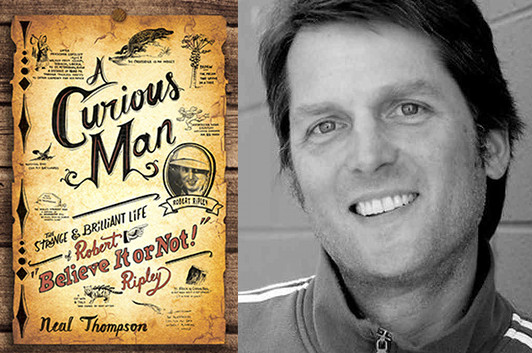Neal Thompson’s Ultimate Underdog Tale

photo: NealThompson.com
A Curious Man is the story of Robert Ripley, a cartoonist who became not just one of 20th-century America’s most successful media personalities, but actually shaped the nation’s popular speech—the Ripley who made “Believe It or Not!” a catch phrase. Neal Thompson tells us what led him to tell that story—and he’s got a detail of special relevance to this blog. “Beatrice was the name of Ripley’s wife, a beautiful Zeigfeld Follies dancer,” he reports. “Their volatile three-year marriage ended in divorce, but they stayed in touch the rest of their lives. Hoping that’ll be the same for me and you, Beatrice.”
I’ve always been fascinated by the origins of books—mine and others, and especially nonfiction. Over the years, I’ve spend a lot of time meeting with and interviewing other authors, and I always have to ask: Why devote two, three, five years of your life to this person? Why thisstory? Now I get to challenge myself with the same question: Why invest half a decade in researching and writing the life of Robert Ripley?
For me, committing a chunk of my life to a particular life story requires two qualities: a come-from-behind arc, and an aspiration toward excellence. In most cases, my ideas ferment for years before they feel ready to be uncorked. In the case of Ripley, though, it was uncorked love at first site.
Unlike my previous books, I can pinpoint the exact day this story became my inspiration-slash-obsession: August 24, 2007. That’s the day I read a New York Times article about a Ripley’s Believe It or Not museum opening in Times Square. The story included a brief description of Ripley the man, and something clicked. “Oh yeah,” I thought. “There was a real guy named Ripley. I wonder what he was like?” Six years later, I’m still wondering, which is a good sign—I never got bored of this guy.
Among other tidbits, my first frenzied internet search that day in 2007 turned up the following: Though shy and bucktoothed, Ripley became a renowned ladies man who had multiple girlfriends living with him at once—an actual harem; he was earning half a million dollars a year at the low-point of the Depression, living in a mansion on a private island, where he’d host massive Hefneresque parties; as a radio pioneer, he broadcast shows from underwater, midair, inside Carlsbad Caverns, and from the bottom of the Grand Canyon—the last an event that helped launch Barry Goldwater’s political career; he traveled to scores of countries, covering more than 100,000 miles in 1933-34 alone, but never drove a car; he was the model for Bugs Bunny’s nemesis, Elmer Fudd. Even Ripley’s death and final resting place had an eccentric twist: he died during the taping of his 13th TV show—an episode featuring the burial song, “Taps”—and he’s buried at Odd Fellows Cemetery, just blocks from his childhood home in Santa Rosa, California.
The other inspiration was realizing that Ripley’s story—which had never been fully told before—was the ultimate underdog tale. I’ve always been drawn to underdogs, and most of the real-life characters in my books had some sort of underdog quality. Alan Shepard (profiled in Light This Candle) was a skinny kid, a rebel, and a trouble maker, who was almost kicked out of the Navy but went on to become America’s first spaceman. The southern moonshiners in Driving with the Devil were poor and undereducated but found their bliss behind the wheel of a Ford V-8. The football players in Hurricane Season recovered from the devastation of Katrina to bring their school and their team to a state championship.
Having grown up with a sister who had a disability (Down syndrome), I’ve always appreciated those who overcome some hardship or setback, who challenge themselves and accomplish something remarkable. Even better is a character who, despite his or her setbacks, strives to live a large, over-the-top life, to push themself to a physical or emotional extreme in order to achieve the unachievable. I’m awed by the people I write about (just as I was awed by my sister), and my books are all efforts to share that awe.
I’ve been awed by Ripley every day since that six-years-ago discovery. In fact, seeing A Curious Man in print is in some ways a relief. When I first latched onto Ripley’s story that day, I felt as if I’d discovered a hidden treasure, some forgotten slice of Americana. Over the years, I’ve battled nerves and paranoia, imagining another writer coming across the same Times story and having the same “holy s**t” realization.Now, I can only hope that readers enjoy the wild ride of Ripley’s rambling life and over-the-top lifestyle. I also hope they’ll experience the same unexpected sense that I developed, which is that Ripley’s influence is all around us, sixty-plus years after his death. As one early reviewer put it, “The world Ripley created is the world in which we now live.”
13 May 2013 | guest authors |

 Our Endless and Proper Work is my new book with Belt Publishing about starting (and sticking to) a productive writing practice.
Our Endless and Proper Work is my new book with Belt Publishing about starting (and sticking to) a productive writing practice. 
